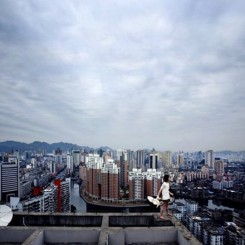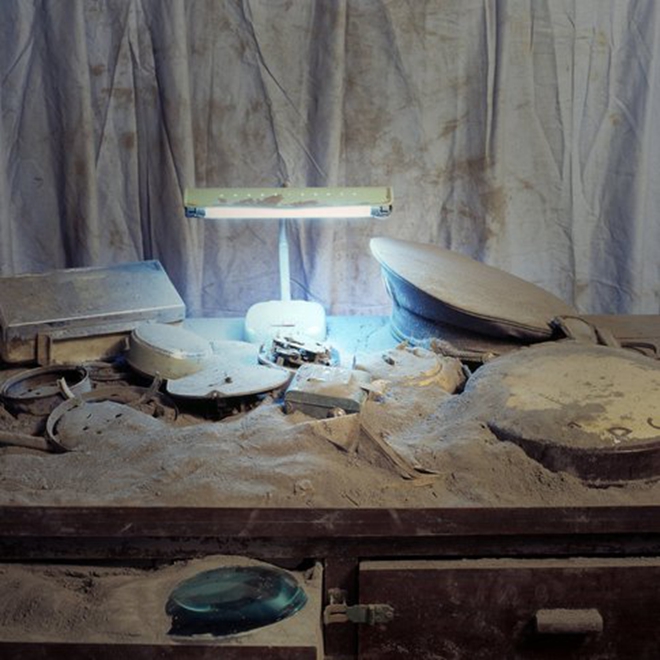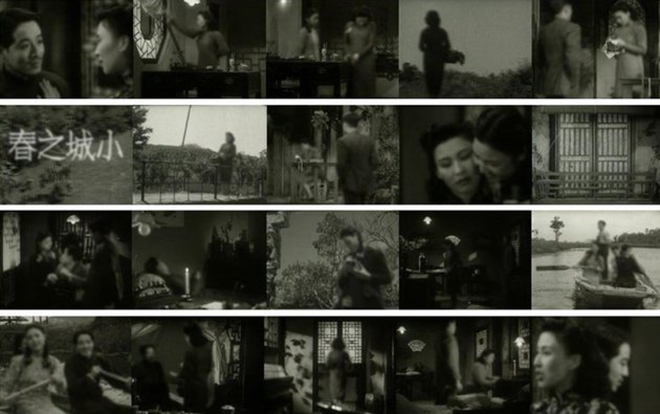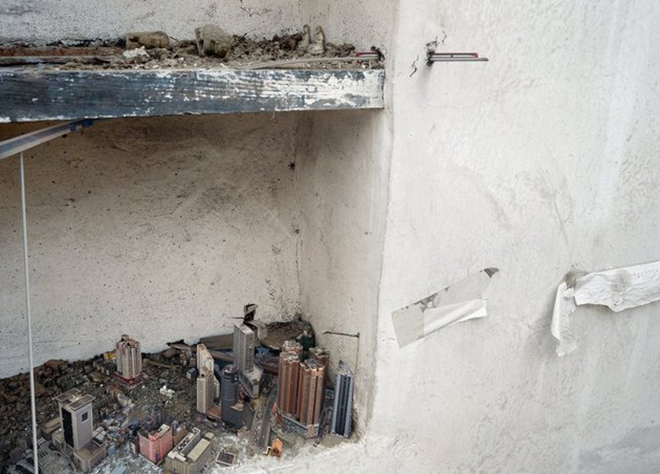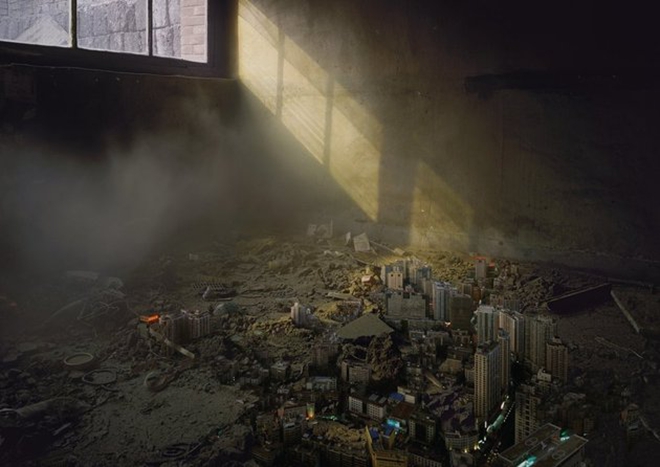“The Other Wave” of photography and video art from China has emerged within the context of Chinese economic growth and the 1980s “New Wave” avant-garde. The press release from Ben Brown contextualizes the works within contemporary Chinese art history by highlighting the “shattered auction results in recent years” of high profile painters. At the same time, it underlines the fact that, “there is another generation emerging from China, with a voice demanding to be heard.” Despite these attempts to situate the work in an historical milieu, the beauty and heart of the exhibition is found in the quiet and meditative spaces that the artists are searching to visualize. Often these spaces are poetic and even mesmerizing, with figures wandering lost or compelled forward by the rapid overwhelming forces of mega-city growth and social transformation.
At first glance Jiang Pengyi’s “Unregistered City No. 1” (2008-2010) is an atmospheric photograph of an abandoned sun-lit, dusty and detritus filled room which resonates with an aura of poetic absence and meditative mystery. The images invite us to daydream, burrowing deep into our inner thoughts; but at the same time these surreal corridors are populated by miniaturized aerial views of cityscapes growing like moss and mushrooms. It’s a dreamscape that compresses and distorts different scales into a dystopic wonderland. His other series of photographs in the show appear at first to be conventional and even generic images of the city but the patterns of movement of the citizens are too organized and take on the feel of people falling into ordered lines of obedience. It’s as if the skyscrapers are resonating a magnetic field that is making the people move as part of a herd mentality.
The stillness in Chen Wei’s highly composed photography belies the greater transformative forces of urban development that swirl around the individual, whose plight is like a captured moment in the eye of the storm. The still images convey a cinematic-like narrative that is never fully revealed but rather implied with the props, setting and lighting. “Other Postman” (2007), for example, depicts a man who seems resigned to walk into the darkness, leaving a paper trail that will never be delivered; the social contracts of his job scattering on the road that leads him ambiguously back home or into the lost depths of the urban environment. “The File Clerk” 2007 depicts a solitary man walking towards us on a watery pathway that is perhaps the top section of a reservoir wall. He leaves behind him the misty cityscape with his bag discarded and the papers that have escaped from it stuck to the wet ground. Has he given up, been fired, lost his mind or consciously decided to abandon his urban existence? Where is he going anyway? All these questions are left to us to answer, to question the life choices any of us make and the feelings of loss, identity and purpose within a world that is changing at break-neck speed.
Cheng Ran’s photograph “The Still of Unknown Film” (2008) depicts a 100-dollar bill burning with film-noir like red embers of neon in the background. It is an image reminiscent of the hedonistic excesses of the 80s with stock traders burning high-value notes to light their cigars. This image projects a desire for a glamorous life-style, steeped with a sense of seedy danger. His other photo “Ghost of Tundra No. 1”, 2010 features a ramshackle substitute “Hollywood” sign made of sticks. Shot from the base of the hill, it is precariously perched on the edge of a cliff. Here Cheng suggests a primitive perspective of wanting to emulate “dream factories” products and the celebrity culture of Hollywood but the epic failure to achieve it.
With Ye Linghan’s “The Spring of The Small Town” (2010), I am uncertain if the images of film stills with blurred faces are real, existing old footage or if they are made up to look like they are from the past but the effect is unnervingly haunting, as if these are now anonymous ghosts floating in a lost narrative. These characters are like faceless spirits forever re-enacting the same scenes of romance and recurring dreams of a rose-tinted past. The title, which makes reference to the film by Fei Mu, also contrasts the youthful flush of romance and innocence with the instant growth of the mega-cities in China.
The curator has drawn together artists who share concerns and critiques about the rise and rapid development of China and its impact on the human psyche. Jiang Pengyi comments on the ecological impact of mega-urban growth and also the invisible forces of the city that determine patterns of urban migration. Chen Wei, is similarly interested in the omnipotent power of the city, and its effect on the individual. He explores how it forces us to existentially confront what it means to transform our identities at the ideological and physical margins. His use of cinematic narrative and devices overlaps with the work of Cheng Ran, which seems to revel in the dreams and promises of a developed city. But at the same time there is a sense of hedonistic menace with the burning of money and seductive desperation in the mimicking of something like Hollywood ambitions and dreams. Ye Linghan’s film stills recall the romance of Chinese cinema, yet at the same time melancholically acknowledge the fading ideals of that era.
In analyzing these perspectives we can see that this is not an exhibition about the glorious declaration of something but rather the universal importance of questioning and meditating on who we are and why we are here.
Gordon Cheung’s next solo show will be at Edel Assanti this September in London. Also seegordoncheung.com

